D-15 chemical tank: unsuccessful platform
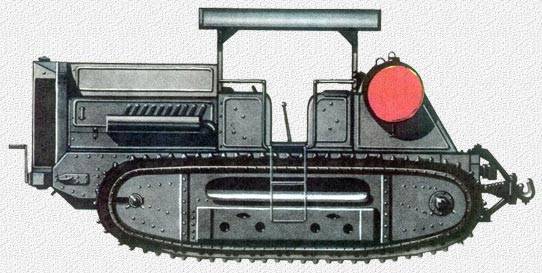
The Kommunar tractor is the basis for an entire line of armored vehicles. Figure Bronetehnika.narod.ru
During the First World War, the idea of a chemical tank or an armored car - a special armored vehicle carrying and using chemical warfare agents or performing degassing. In our country, such ideas reached practical implementation only in the early thirties. The first model of this kind was the D-15 tank, created under the leadership of N.I. Dyrenkova.
On the way to the project
The concept of chemical machines in our country has not been implemented for a long time, and such work has been repeatedly postponed for the future. Only in 1929-30. The Department of Mechanization and Motorization of the Workers 'and Peasants' Red Army (UMM RKKA) launched the development of real projects of this kind.
The development of the first chemical tank in our country started at the end of 1930. It was entrusted to the UMM Experimental Design and Testing Bureau (OKIB), whose head was the famous designer Nikolai Ivanovich Dyrenkov. The development was completed in the shortest possible time, and already at the beginning of 1931, the necessary documentation was transferred to production. The chemical tank received the designation D-15.
Tank D-15 was part of a major program for the construction of armored vehicles. In October 1930, the Revolutionary Military Council decided to develop and test about two dozen armored vehicles of different classes based on serial tractors of domestic production. Four such samples were developed at OKIB UMM. Machines with the indices D-10 and D-11 were "tanks" with cannon-machine gun weapons; The D-14 was an amphibious tank, and the D-15 was a "chemical attack tank."
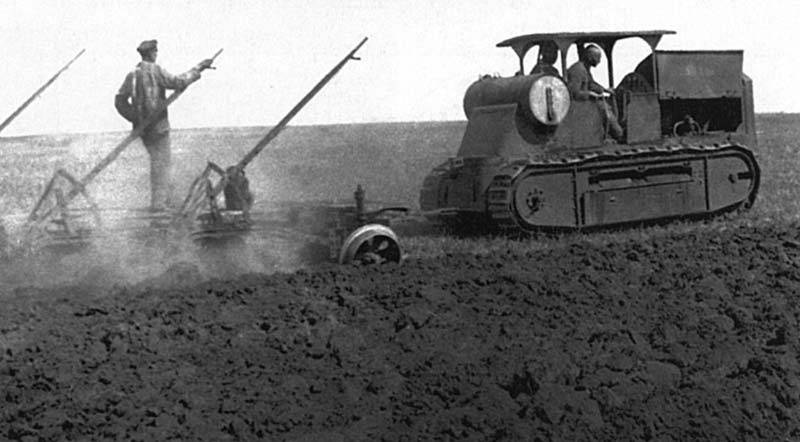
Tractor at main job. Photo by Bronetehnika.narod.ru
Unfortunately, not a single photograph of the D-15 chemical tank has been preserved. However, the available data on the line suggest that the tanks were unified with each other. The chemical D-15 could well have a constructive resemblance to the cannon-machine gun D-10.
Based tractor
As a base for the D-10 and D-15, the crawler tractor Kommunar 9GU was selected, which was produced by the Kharkov Steam Locomotive Plant and widely used in the national economy. OKIB's projects included the removal of all unnecessary equipment from the tractor and the installation of new units.
The crawler Kommunar had a layout traditional for such a technique with a front engine, behind which was the cab. At the rear there was a platform for a fuel tank and payload. The tractor was built on the basis of a riveted metal frame, which included the power elements of the caterpillar mover. Due to the lack of soft suspension, the tractor had to experience high loads, and the power set had sufficient strength and adequate weight.
"Communards" of various modifications were equipped with different engines. Most likely, OKIB used tractors with gasoline engines rated at 75 hp. A mechanical transmission with a taper main clutch, a three-speed gearbox, a main bevel gear, as well as two side clutches and two final drives was used. The fuel system included a tank on 245 l.
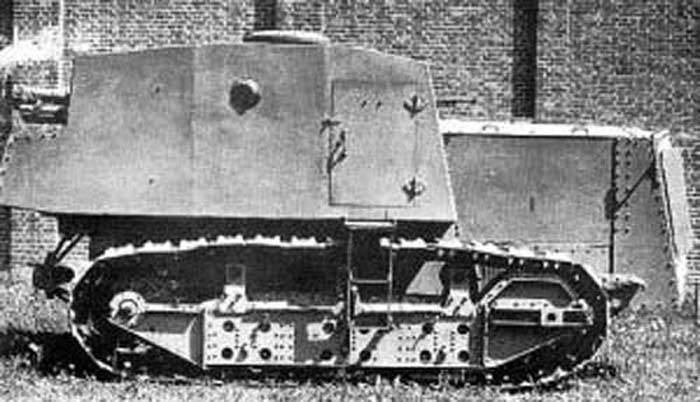
Experienced tank D-10. Chemical D-15 was like him. Photo Strangernn.livejournal.com
The chassis had seven small road wheels on each side. Elastic elements were absent. There was a steering wheel in the front of the chassis, and a drive wheel in the back. On its own supports, three support rollers were mounted on the caterpillar.
For the cannon tank D-10 and, probably, for the chemical D-15, an armored body of the bonnet layout with a common inhabited compartment was developed - it served as a control and fighting compartment. The case was assembled on rivets of armor plates. The frontal projection received bulletproof protection with a thickness of 16 mm, the sides consisted of 11-mm sheets. The least protection was given by the 6-mm roof.
On the D-10, the engine cover was a box with hatches for access inside and shutters on the front wall. The inhabited part of the hull had an increased width with full-fledged caterpillar niches. For mounting the gun on the D-10, there was a stern installation located above the L-shaped stern of the hull. Whether such feed was used on the D-15 is unclear.
In the frontal sheet of the inhabited compartment there were inspection hatches. On the roof was a cylindrical commander’s cupola with observation instruments. In front of the sides, doors were provided for access to the car. On the perimeter of the inhabited compartment there were manholes and ball mounts for the machine gun.
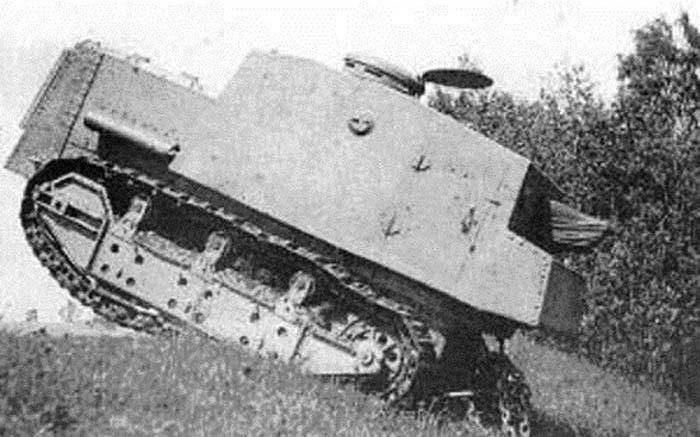
Overcoming obstacles. Photo Strangernn.livejournal.com
For self-defense, a chemical tank had to use two DT machine guns. One of them was nominally located on the installation of the frontal sheet and fired at the front hemisphere. The second machine gun was proposed to be transported in a stack and placed in battle on existing installations.
In the fighting compartment of the D-15 tank, special chemical equipment was placed. The machine was equipped with two tanks for liquids with a capacity of 2 thousand liters. Using pipelines, they connected to pumps and two spray devices. The “chemical attack tank” could carry various types of liquids designed to solve various combat missions.
The main objective of the D-15 tank was to spray BOW. For this, the machine had to take liquid weapon and move the area, spraying it. After the necessary processing, the chemical tank could perform the inverse task. In this case, degassing solutions should be poured into the tanks. Finally, certain chemical compounds were intended for setting smoke screens. In all cases, the operating principles of the chemical tank were the same, but the “payload” was seriously different.
The tanks on the Kommunar tractor chassis developed by OKIB had approximately the same dimensions and combat weight at the level of 10,5-11 tons. The chemical tank was heavier - 18 tons. The maximum speed of such equipment should not exceed 7-8 km / h. Cruising range - 240 km. The specific undercarriage did not allow for outstanding cross-country performance.
On trial
At the very end of 1930, tractor documentation went to the MOZHEREZ plant (the future Lublin Foundry and Mechanical Plant), which was to assemble four prototypes. The D-10 and D-11 tanks were made 1931 in early February, after which the construction of the experimental D-14 transporter and the D-15 chemical armored vehicle began. In May, the customer was given the D-14 car. The assembly of the D-15 was delayed.
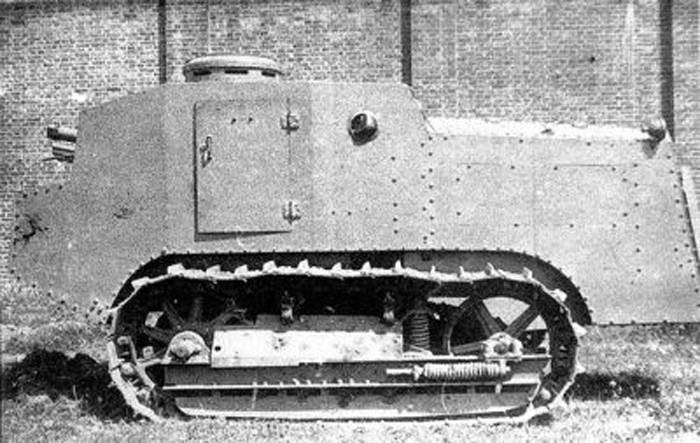
Tank D-11 is another member of the family. Photo Armor.kiev.ua
In May 1931, three finished tanks were sent to the UMM Scientific Testing Armored Range (Kubinka station). In early June, the vehicle completed an 95 km run along the highway, dirt roads and off-road. The average speed on a route with various obstacles was 4-6 km / h. After the run, the tanks received comments.
In early June, all three experimental tanks had to be put up for repair. UMM recommended restoring the equipment, finalizing it and re-checking it on the track. However, this never happened. The D-10, D-11 and D-14 armored vehicles stood idle for a while, and then the army decided to write them down and disassemble them.
Accurate data on the fate of the chemical tank D-15 are not available. According to one source, the tank was completed at the beginning of the summer of 1931, when other vehicles passed the first tests. Due to the indefinite status of “brothers,” the tank remained at the MOZHEREZ plant until the end of 1932. After that, it was disassembled after other tanks based on tractors.
According to other sources, the D-15 was still able to go on sea trials. However, the tank showed characteristics at the level of other samples and did not suit the customer. Mobility on the ground was unsatisfactory, and two tanks on 4 thousand liters of payload negatively affected it. After testing, the tank was put into storage, and in 1932, it was dismantled for spare parts.
Which of the sources is closer to the truth is unknown. However, they agree on one thing. The D-15 tank and other vehicles on a tractor chassis did not show high mobility characteristics and were not of interest to the army. For this reason, already in 1932, they were sent for disassembly. From the D-10 and D-11 tanks, as well as the D-14 transporter, only photos were left. The D-15 chemical tank, the first in our country, was less fortunate - now its exact appearance is unknown.
It should be noted that the UMM RKKA did not criticize the concept of a chemical tank, but the platform used in its implementation. Therefore, work on chemical armored vehicles continued. Already in 1931-1932. new samples of this kind appeared. Specialists of OKIB UMM and engineers of other organizations took part in their creation.
Information